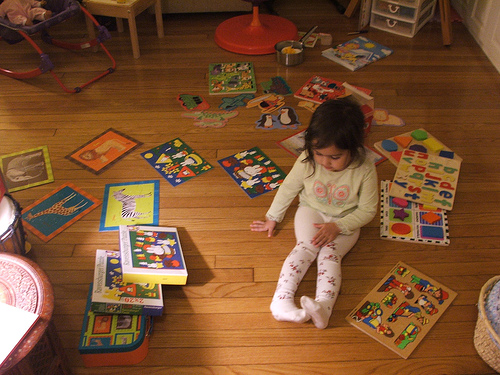Have you seen Amie puzzling (video to the right)? She was only 18 months old and really into it: fit-the-shape peg puzzles as well as jigsaw puzzles. After a while she lost interest and moved on. I wasn’t heart-broken, because I knew that by then she had memorized all the puzzles and wasn’t, therefore, really puzzling anymore. I described all this in First Puzzles for a Child Under Two Years.
Today she asked to make puzzles again. I had to dig them out from behind hundreds of children’s books (I am not kidding). Two hours later, this was the result:

As before, I mixed up the 16 same-shape-and-size but different-pattern pieces that fit into two boards (described in A Child’s First Puzzles), and the 16 geometrical shapes that also go into two different boards. She wasn’t even challenged.
- Touch still first, visuals second
Then I also mixed up the pieces of the eight 4-piece jigsaw puzzles (the penguins, etc. that she puts together in the old video). This was a way of forcing her to look at the images first, before resorting to the shapes and the fit of the pieces. She had no trouble with selecting the right pieces, but when she turned to the puzzling, it was clear that she is still predominantly guided by touch.
Even so, though she was still and often trying to fit a corner piece (which seems to be a visual, not a tactile clue) into the middle of a puzzle, or trying to attach the zebra’s head to his tail, it was much easier to talk her through it. I merely had to point out to her that it was a corner she was holding, and that she might use it to fix the zebra’s head, or that it might fit in the upper left corner, if she turned it a bit, and she was on it.
- “Fix it” with visual and directional pointers
Most of my help was purely verbal. “Why don’t you fix the zebra’s head” and “fix the giraffe’s neck?” were sufficient pointers. I found that the combination of the word “fix” and a brief description of the two parts she is supposed to join together seems to be the best way of directing her to pay attention to the image.Â
Alos invaluable were the directional clues: “to the left, right, above and below” this or that piece. “Turn it a little”.

Thus we moved up to the little suitcase, the Crocodile Creek collection of four puzzles: one 4 pieces, one 6, one 8 and one 12 pieces. They’re tough: they certainly not designed with young toddlers in mind. Most pieces have a jumble of zebra stripes or simply a flat expanse of background that even I had to study closely to figure out where they went! But I talked her through even the biggest puzzle simply by giving her visual clues about the image and directional clues about where it should go relative to the other pieces.

- 24 pieces!
In the end we did two 24-piece puzzles of “Nijntje” (in the picture they are right behind her right hand). Even those she completed without my even touching a single piece. And in the end she was getting the hang of it.
“Let’s fix the rabbit’s head,” she mumbled. When I pointed out that she might turn it around, she said: “Don’t worry, Mama, I’ll do it. I’ll try. I’ll do my best.”
I trust you, dear. Don’t worry.
(Check out more pictures of our puzzling adventure today in my Flickr badge)
Your child is beautiful. Just a very long note. Puzzles are designed for multiple purposes as you know. As you have seen touch is the primary design use for young children. The reason is that touch comes before visual just as visual comes before auditory. It is related to the part of the brain that is used for grammar and is also the used for a person’s hands for tool making. If a child is allowed to get as far as they can with a puzzle, even putting a piece they cannot solve for to the side and finishing other parts first, they will then “discover” where the hard to fit piece goes in the end, corner pieces are usually last. But the more out of sequence a child learns to put together a puzzle prior to them self discovering the right answer the more depended they will be on outside help.The children solve puzzles in different order then adults because they need to discover the shortcuts themselves. They will also doubt themselves if they can not solve the puzzle in a certain amount of time, if say a parent , after 5 minutes of watching the child, gives the cue. A parent teaches a child that if it is not solved for after 5 minutes then turn for help. This reduces persistence when the time comes for them later in life. I work with engineers. I asked them all what made them so good at what they do (I only hire the creative ones) they all said they were given blocks and puzzles and left to work on them by themselves while mom went and did the dishes. So, I did this with my daughter. At three she was up to 50+ piece Jigsaw puzzles and very determined for us not to help unless she came to us for it, so that she may surprise us with her compliments. We bought so many that the town toy store manager knew of her ability and even started to guide us towards more open ended engineering type toys and stocked toys that interested her. I found that I like to hover, which put pressure on her, and her insistence that she wanted to play with the toy, “Go away mommy. I do it myself.” She was right.